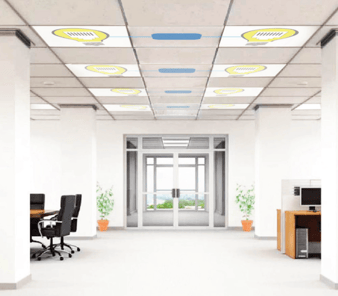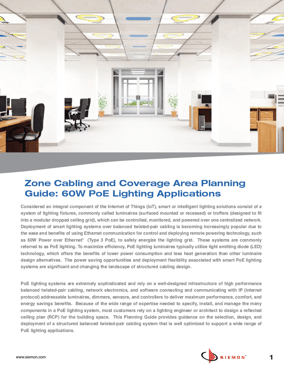Considered an integral component of the Internet of Things (IoT), smart or intelligent lighting solutions consist of a system of lighting fixtures,  commonly called luminaires (surfaced mounted or recessed) or troffers (designed to fit into a modular dropped ceiling grid), which can be controlled, monitored, and powered over one centralized network. Deployment of smart lighting systems over balanced twisted-pair cabling is becoming increasingly popular due to the ease and benefits of using Ethernet communication for control and deploying remote powering technology, such as 60W Power over Ethernet1 (Type 3 PoE), to safely energize the lighting grid. These systems are commonly referred to as PoE lighting. To maximize efficiency, PoE lighting luminaires typically utilize light emitting diode (LED) technology, which offers the benefits of lower power consumption and less heat generation than other luminaire design alternatives. The power saving opportunities and deployment flexibility associated with smart PoE lighting systems are significant and changing the landscape of structured cabling design.
commonly called luminaires (surfaced mounted or recessed) or troffers (designed to fit into a modular dropped ceiling grid), which can be controlled, monitored, and powered over one centralized network. Deployment of smart lighting systems over balanced twisted-pair cabling is becoming increasingly popular due to the ease and benefits of using Ethernet communication for control and deploying remote powering technology, such as 60W Power over Ethernet1 (Type 3 PoE), to safely energize the lighting grid. These systems are commonly referred to as PoE lighting. To maximize efficiency, PoE lighting luminaires typically utilize light emitting diode (LED) technology, which offers the benefits of lower power consumption and less heat generation than other luminaire design alternatives. The power saving opportunities and deployment flexibility associated with smart PoE lighting systems are significant and changing the landscape of structured cabling design.
PoE lighting systems are extremely sophisticated and rely on a well-designed infrastructure of high performance balanced twisted-pair cabling, network electronics, and software connecting and communicating with IP (internet protocol) addressable luminaires, dimmers, sensors, and controllers to deliver maximum performance, comfort, and energy savings benefits. Because of the wide range of expertise needed to specify, install, and manage the many components in a PoE lighting system, most customers rely on a lighting engineer or architect to design a reflected ceiling plan (RCP) for the building space. A new planning guide from Siemon provides guidance on the selection, design, and deployment of a structured balanced twisted-pair cabling system that is well optimized to support a wide range of PoE lighting applications.




.png?width=58&height=58&name=X_logo_2023_(white).png)
